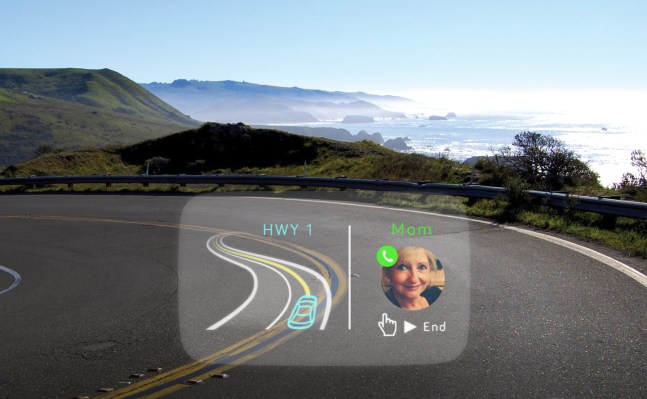Frustrated with using the built-in infotainment system and his phone in his car, Doug Simpson, CEO and founder of Navdy, decided to create a Google Glass-reminiscent heads-up display to create a new and safer way to interact with smartphones while driving.
Now I know what you’re thinking — why is he using his phone while driving? Nowadays, smartphones have replaced built-in navigation systems and music players. But like these navigation systems, the touchscreen controls take the driver’s eyes off the road, increasing the chance to get into an accident by three times, according to the National Highway Traffic Safety Administration (NHTSA).
“At any given daylight moment across America, approximately 660,000 drivers are using cell phones or manipulating electronic devices while driving, a number that has held steady since 2010,” according to the NHTSA.
Navdy wants to change the way we interact with our connected devices while driving altogether. It’s a device that can be mounted on any car’s dashboard and it provides a high-resolution heads-up display that helps you see the road behind it. Simpson says the technology is the same used by pilots when they land an airplane.
By seeing what’s behind the display and still receiving information from it, the driver doesn’t take his or her eyes off the road, which should decrease the chances of an accident according to the NHTSA, which released guidelines last year to minimize in-driving distractions such as manual text entry on navigation systems.
The device is powered by plugging it into the on-board computer, which cars manufactured since 1996 should have. Once it connects to your phone via Bluetooth, Its voice and gesture controls allow you to take calls, reply to texts and ask for directions without having to pick up your phone. You do need the iOS or Android app to help set up the device.
This HUD technology has been around for a while, as many high-end cars have already implemented them, but GPS manufacturer Garmin announced the Garmin HUD last year, which costs a lot less than Navdy and doesn’t require an on-board car computer connection. The downside of the Garmin HUD is that it only works with the company’s apps.
Simpson said when you use your smartphone as a navigation system, a sudden call could disrupt navigation and leave you confused on which way to go. This is one of the reasons he believes smartphones are not designed to be used in the car. Navdy will split the screen when using a navigation app and when a second notification such as a call or text message is received. The device is compatible with a variety of apps such as Google Maps and Pandora.
When it is linked to the car’s on-board computer, it can also project speed, RPM, fuel economy stats, tire-pressure warning or battery-voltage warning, among others. Users can customize the display to show something specific, such as a large RPM dial in the center.
The company launched a 30-day pre-order campaign today, where early adopters can purchase the product at $299. The retail price of Navdy is $499. They’re also implementing a referral program that if you refer someone to Navdy, you can get $30 in credit.
